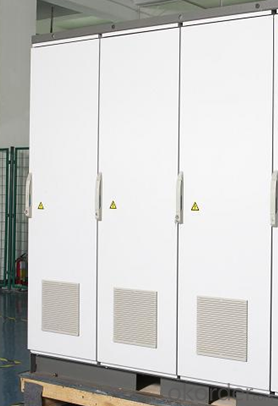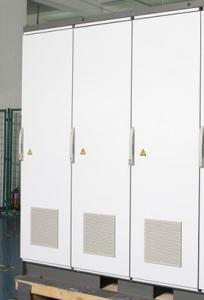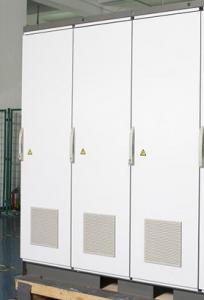PV Off-Grid Inverter and Controller Hybrid GNS-0.3KB
OKorder Service Pledge
OKorder Financial Service
You Might Also Like
Description;
CNBMSOLAR is a world-leading and Vertical integrated manufacturer of high-performance with Silicon,
Wafer, Cells, Modules, which convert sunlight into electricity for residential, commercial, and utility-scale
power generation.
The capacity of CNBMSOLAR is reach to 1GW, and make sure each year our shipment capacity is more
Than 700-800MWs, at the same time, we have set up the largest solar power station with our partner
in Ukraine.
CNBM is a Quality + Service oriented company with“Excellence at Each Step” approach, composed of
the finest components from TUV and IEC-certified partners around the world, CNBM modules consistently
undergo a variety of trials at the company’s Test & Development Centre, ensuring peak performance
capabilities. The company is committed to develop and provide the world with clean and renewable energy
to ease the energy shortages as well as human kind’s impact on the environment.
Data:
Technical specifications |
| |
Model | GNS-0.3K20B | |
Rated Capacity(KVA) | 0.5 | |
DC Input | Rated Voltage(VDC) | 12 |
Low Voltage(VDC) | 10.8 | |
Low Voltage Resume (VDC) | 13.2 | |
Load Overvoltage(VDC) | 17 | |
Overvoltage Resume(VDC) | 16.5 | |
PV Input | Rated Current on charging(A) | 20 |
Charge Loop | 1 | |
Overcharge protection(VDC) | 14.4 | |
Overcharge Resumption(VDC) | 14.2 | |
Anti lightning | varistor lighting protection | |
Grid input | No grid transfer function | |
Rated capacity | Output Waveform | sinewave |
Overload ability | 120% 1min | |
Output voltage(VAC) | 220±3% | |
Output frequency(Hz) | 50±0.1% | |
THD | ≤3℅(THD) | |
Dynamic Response(0~100%) | 5% | |
Efficiency | ≥80% | |
Continous running time | Continuous operation | |
Display | LCD/LED/Meter | |
Protection | Overcharge, overdischarge, overload, short circuit, reverse polarity, internal overheated protections,etc | |
Protection class | IP20 | |
Environment | Noisy | ≤50(dB/m) |
Operating temperature range | -10~+50(℃) | |
Storage temperature range | -25~+55(℃) | |
Operating humidity | 0~95%(non-condensing) | |
Max.altitude(above sea level) | ≤5000(m) | |
Product Dimension (mm) | 520*273*451 | |
Weight(kg) | 80kg | |

FAQ:Could you introduce more about CNBM
CNBM Group is short for China National Building Materials Group Corporation, which is established in 1984 with approval from the State Council
CNBM Group is the largest comprehensive building materials industry group in China
The Group has a total asset of over RMB 360 billion, more than 180,000 employees and 17 subsidiaries
- Q:Can a solar controller be used with solar panels that are connected to a solar concentrator?
- Solar panels connected to a solar concentrator can indeed be used with a solar controller. The solar concentrator is a device that concentrates sunlight onto a smaller area, thereby increasing the intensity of the light and the energy that can be harvested. The solar controller's role is to regulate the charging and discharging of batteries in a solar power system. When used in conjunction with solar panels connected to a solar concentrator, the solar controller ensures efficient and safe battery charging. It does so by monitoring the incoming voltage and current from the solar panels and adjusting the charging parameters accordingly. Therefore, it is highly recommended to use a solar controller with solar panels connected to a solar concentrator in order to optimize the performance and longevity of the solar power system.
- Q:Can a solar controller be used with different types of solar batteries?
- Different types of solar batteries can be used with a solar controller. The main function of a solar controller is to regulate and control the charging process of the solar batteries. It ensures that the batteries are charged optimally and prevents them from being overcharged or undercharged. Various types of batteries, including lead-acid, lithium-ion, gel, or AGM batteries, can be used with solar controllers. These controllers usually have adjustable charging parameters to meet the specific requirements of different battery chemistries. However, it is crucial to select a solar controller that is compatible with the particular type of battery in use to ensure proper charging and prolong the batteries' lifespan.
- Q:How does a solar controller handle battery temperature monitoring and protection?
- A solar controller handles battery temperature monitoring and protection by constantly monitoring the temperature of the battery. This is typically done by using a built-in temperature sensor or by connecting an external temperature sensor to the controller. The controller measures the temperature of the battery and compares it to a predefined temperature range. If the temperature falls outside of this range, the controller takes appropriate actions to protect the battery. If the temperature exceeds the upper limit, the controller may reduce the charging current or completely disconnect the solar panels from the battery to prevent overcharging and potential damage. This is important because high temperatures can lead to accelerated battery aging and reduced battery life. On the other hand, if the temperature drops below the lower limit, the controller may adjust the charging voltage to prevent undercharging. Cold temperatures can significantly affect the battery's performance and capacity, so it is crucial to ensure proper charging in such conditions. In addition to these protective measures, some advanced solar controllers may also offer temperature compensation. They adjust the charging parameters based on the battery temperature to optimize charging efficiency and prolong battery life. This compensation is particularly valuable as it helps to counteract the temperature-related variations in battery chemistry and performance. Overall, through continuous temperature monitoring and appropriate protective actions, a solar controller ensures that the battery operates within a safe temperature range, maximizing its lifespan and optimizing its performance.
- Q:What is the maximum temperature range that a solar controller can handle?
- The temperature range that a solar controller can handle differs based on the particular model and manufacturer. Nevertheless, most solar controllers are generally built to function in temperatures ranging from -40°C to +85°C (-40°F to +185°F). These temperature boundaries are established to guarantee the best performance and safeguard the controller's internal parts. It is essential to understand that surpassing the specified temperature range could lead to decreased efficiency or potentially harm the controller. Therefore, it is crucial to thoroughly assess the environmental conditions and choose a solar controller capable of enduring the anticipated temperature range at the installation site.
- Q:How does a solar controller handle load control and diversion charging?
- A solar controller handles load control and diversion charging through its built-in features and capabilities. Load control refers to the management of power distribution to various loads or appliances connected to the solar system. Diversion charging, on the other hand, involves the redirection of excess energy produced by the solar panels to charge additional devices or batteries. To handle load control, a solar controller typically offers multiple load terminals or outputs. These terminals can be connected to different electrical loads, such as lights, fans, or other appliances, allowing the controller to control the power flow and regulate the energy consumption of each load. This ensures that the available solar power is efficiently utilized and prevents overloading of the system. Diversion charging is achieved by connecting a diversion load, such as a dump load or a secondary battery bank, to the solar controller. When the solar panels generate more energy than the connected loads require, the controller diverts the excess power to the diversion load. This prevents the batteries from overcharging and maximizes the utilization of the solar energy. Solar controllers often employ sophisticated algorithms and monitoring systems to determine when to activate load control or diversion charging. These algorithms take into account various factors, such as battery voltage, solar panel output, and load requirements, to make intelligent decisions regarding power distribution and diversion. Some controllers even feature advanced MPPT (Maximum Power Point Tracking) technology, which optimizes the solar panel output and ensures efficient power conversion. In summary, a solar controller handles load control and diversion charging by providing multiple load terminals for power distribution and diverting excess energy to a diversion load. It utilizes algorithms and monitoring systems to make intelligent decisions and optimize the utilization of solar energy.
- Q:Can a solar controller be connected to a computer or smartphone for monitoring?
- It is possible to connect a solar controller to a computer or smartphone for monitoring purposes. Many modern solar controllers come with built-in communication ports like USB or Bluetooth, which allow them to be easily connected to a computer or smartphone. By using the appropriate software or mobile applications, users can conveniently monitor and control their solar systems remotely. This connectivity feature makes it possible to monitor solar panel performance, battery status, charging/discharging rates, and other important data in real-time. Moreover, advanced solar controllers even support internet connectivity, enabling users to monitor their systems from anywhere in the world through a web-based interface or dedicated mobile apps. In general, connecting a solar controller to a computer or smartphone significantly improves the convenience and accessibility of solar system monitoring.
- Q:Can a solar controller be used with a solar-powered event space?
- Yes, a solar controller can definitely be used with a solar-powered event space. A solar controller regulates the flow of electricity between the solar panels and the battery bank, ensuring optimal charging and preventing overcharging or damage. It is an essential component in any solar-powered system, including event spaces, as it helps maximize energy efficiency and maintain a stable power supply.
- Q:Can a solar controller be used in a grid-tied solar power system?
- Indeed, a solar controller has the potential to be utilized within a grid-tied solar power system. However, it is imperative to acknowledge that the primary function of a solar controller lies in regulating the charging and discharging of batteries within an off-grid solar system. In the case of a grid-tied system, the solar panels are directly connected to the utility grid, rendering battery storage unnecessary. Within a grid-tied solar power system, the role of the solar controller is confined to monitoring the performance of the solar panels and ensuring efficient electricity production. The controller may also offer data logging and monitoring capabilities, enabling the system owner to monitor energy production and consumption. Although a solar controller is not a crucial component in a grid-tied system, it can still prove advantageous for the purposes of system monitoring and maintenance. It provides valuable insights into the system's performance and aids in troubleshooting any potential issues that may arise. Moreover, certain solar controllers offer advanced features like MPPT (Maximum Power Point Tracking) technology, which optimizes the energy output of the solar panels, even within a grid-tied system. All things considered, while not essential, a solar controller can still be utilized within a grid-tied solar power system to elevate monitoring and optimization capabilities.
- Q:Are there any safety features in solar controllers?
- Yes, there are several safety features in solar controllers. Some common safety features include overcharge protection, over-discharge protection, short-circuit protection, reverse polarity protection, and temperature compensation. These features ensure the safe and efficient operation of solar controllers and help protect the connected batteries and solar panels from damage.
- Q:How do I protect a solar controller from power surges or spikes?
- To protect a solar controller from power surges or spikes, you can use a surge protector or an uninterruptible power supply (UPS). A surge protector can be connected between the solar controller and the power source, which helps to divert excess voltage away from the controller during surges or spikes. Additionally, a UPS can provide backup power during outages and regulate the incoming voltage to shield the controller from sudden fluctuations.
1. Manufacturer Overview |
|
|---|---|
| Location | |
| Year Established | |
| Annual Output Value | |
| Main Markets | |
| Company Certifications | |
2. Manufacturer Certificates |
|
|---|---|
| a) Certification Name | |
| Range | |
| Reference | |
| Validity Period | |
3. Manufacturer Capability |
|
|---|---|
| a)Trade Capacity | |
| Nearest Port | |
| Export Percentage | |
| No.of Employees in Trade Department | |
| Language Spoken: | |
| b)Factory Information | |
| Factory Size: | |
| No. of Production Lines | |
| Contract Manufacturing | |
| Product Price Range | |
Send your message to us
PV Off-Grid Inverter and Controller Hybrid GNS-0.3KB
OKorder Service Pledge
OKorder Financial Service
Similar products
New products
Hot products
Hot Searches
Related keywords






























